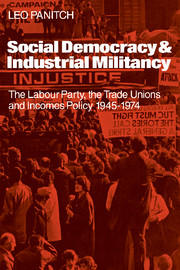 Social Democracy and Industrial Militiancy
Social Democracy and Industrial Militiancy Book contents
- Frontmatter
- Contents
- Preface
- List of Abbreviations
- Introduction
- 1 The 1945 Labour Government: the mixed economy and wage restraint
- 2 Incomes policy and Labour in opposition
- 3 The voluntary incomes policy agreement
- 4 The devaluation of voluntarism
- 5 The politics of wage freeze
- 6 The statutory incomes policy – Labour Government versus labour movement
- 7 ‘In place of strife’
- 8 Industrial militancy and political stagnation
- Conclusion
- Appendixes
- Notes
- Index
1 - The 1945 Labour Government: the mixed economy and wage restraint
Published online by Cambridge University Press: 07 October 2011
- Frontmatter
- Contents
- Preface
- List of Abbreviations
- Introduction
- 1 The 1945 Labour Government: the mixed economy and wage restraint
- 2 Incomes policy and Labour in opposition
- 3 The voluntary incomes policy agreement
- 4 The devaluation of voluntarism
- 5 The politics of wage freeze
- 6 The statutory incomes policy – Labour Government versus labour movement
- 7 ‘In place of strife’
- 8 Industrial militancy and political stagnation
- Conclusion
- Appendixes
- Notes
- Index
Summary
Economic planning and wage restraint
World War II is usually marked as a watershed for the ascension of British trade unions to what Churchill termed ‘an estate of the realm’. Participation in governmental bodies and agencies, and regular and direct consultation with Departments in matters that affected the unions’ interests became accepted as a matter of right. This was a development directly related to the increased intervention by the state in the economy, not least in stabilizing the level and influencing the distribution of wages and salaries. The war-time White Paper, Price Stabilization and Industrial Policy of July 1941, was the first of a series of official pronouncements over the next thirty years which was to put the case that wage increases without matched productivity growth would lead to an inflationary spiral detrimental to the ‘national interest’: apart from increases in productivity, the White Paper, like most of its successors, only allowed for concessions to ‘comparatively low paid grades and categories of workers’. The inegalitarian implications of wage restraint in such a class-divided society as Britain's posed real problems for the unions. The TUC's General Secretary said of the White Paper:
If we were within a society where every section of the community had approximately the same standard of life, the case would be watertight, perhaps, for a common sacrifice by everybody. […]
- Type
- Chapter
- Information
- Social Democracy and Industrial MilitiancyThe Labour Party, the Trade Unions and Incomes Policy, 1945–1947, pp. 7 - 40Publisher: Cambridge University PressPrint publication year: 1976


